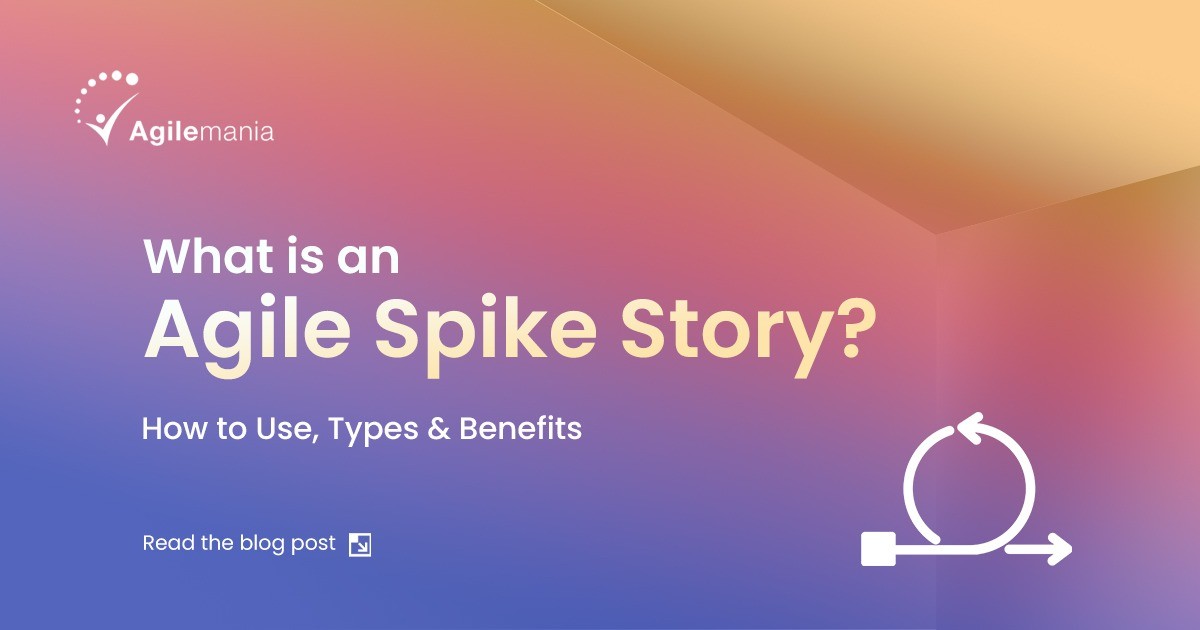
Naveen Kumar Singh
Naveen is a professional agile coach and has been working independently for a long time in the Asia... Read more

Naveen is a professional agile coach and has been working independently for a long time in the Asia... Read more

An Agile spike is a timeboxed experiment meant to gather information to reduce risk and enable more accurate estimates for complex user stories.
Sometimes, teams struggle to estimate a user story because it is too ambiguous or technically challenging. In these cases, they may decide to complete a spike activity first to analyze potential solutions and unknowns.
A spike can take various forms - building a proof of concept, prototyping, researching options, or adding technical validation. The goal is to break down the uncertainty of a complex story so the team has enough confidence to estimate and plan the full feature.
Spikes are meant to be short, often lasting a few hours, days, or weeks, depending on the situation. The learning from the spike is then used to create more defined user stories for future sprints.
An agile spike story is a type of user story focused on investigating potential solutions for a product need identified through customer feedback. A spike is the hands-on activity to explore a complex solution, while the spike story captures and plans for that activity in the backlog.
Unlike typical user stories that detail work to build a feature, spike stories allow engineers to explore if a particular solution is technically feasible to implement. Spikes are timeboxed to a few days or a sprint and aimed at answering specific questions or proving out concepts.
For example, if customers request a complex new feature, the product manager may create a spike for 1-2 engineers to research technologies and build a proof of concept. They are given flexibility to explore the problem space with the goal of determining if the solution is possible within reasonable time and resources.
The spike may involve activities like reviewing documentation, analyzing APIs, prototyping, proof-of-concepts, and technical experiments. The engineers share what they learn so the team can decide if the solution is viable or if alternative options should be considered.
Spike stories enable teams to gain key insights before committing to full feature development. They reduce risk and uncertainty around the best technical approach. By validating feasibility early, spikes ultimately lead to better solutions that delight customers.
An Agile spike is the tactical activity that provides insights, while the spike story is the backlog item used for planning and tracking that activity. Here is a table comparing Agile spikes and Agile spike stories:
| Element |
Agile Spike
|
Agile Spike Story
|
|---|---|---|
| (1) Definition |
An experimental activity to gather information and reduce risk prior to feature development
|
A user story that encapsulates the planning of a spike activity
|
| (2) Purpose |
To enable a greater understanding of a complex problem/solution before full development
|
To coordinate and schedule spike activities within sprint planning
|
| (3) Examples |
Prototyping, proof-of-concepts, research, technical experiments
|
"Investigate potential integration with 3rd party API"
|
| (4) Value |
Provides hands-on insights to derisk stories and support estimation
|
Brings visibility to spikes within the backlog for planning
|
| (5) Duration |
Hours, days, or weeks, depending on the scope
|
Matches the duration of the related spike
|
| (6) Outcome |
Findings and learnings used for future user story refinement
|
Completed spike and learnings to apply to future sprints
|
Get CSM certified and harness the full potential of Scrum for successful product delivery.
Enroll Now
So, till now, we’ve explored what Agile spike stories are and how they help teams investigate and estimate complex user stories.
Now, let's dive into the specifics - how do you write a spike story that delivers maximum value?
Review your product backlog for user stories with major technical unknowns, open-ended UX needs, or other ambiguities that makes estimation difficult. Spikes are most valuable on complex stories to fill critical knowledge gaps for planning purposes.
Look for stories with a lot of risk around feasibility, effort level, or viability of potential solutions
Prioritize spikes for large, epic-level stories versus smaller standalone stories. Collaborate with engineers and designers to understand which complex stories would benefit most from spikes
Define a clear, focused spike goal and boundaries tied to the original user story. A narrow scope prevents waste and keeps the spike targeted on key questions. Limit scope to validating assumptions critical for estimating the larger story rather than full requirements.
Write the title and description in the form of a testable question using "how might we" or "what if" framing. This creates clear purpose and expectations around evaluating a specific hypothesis. Make the question narrow enough to reasonably answer given spike time constraints. Avoid overly broad questions that lead to vague, speculative answers.
Document the hypotheses, constraints, and assumptions that need validation. List technical factors, integration points, and UX concerns that impact feasibility the most. Also, focus on assumptions that could fundamentally change scope, resources, or release plans if wrong.
Keep spikes small - a few hours, days, or at most 1-2 sprints. Scope the spike to target the simplest experiment that will provide useful insights. Remember you are trying to estimate the larger story, not deliver the full solution.
Schedule spikes in the sprints where related larger stories are planned. Time spikes so learnings can inform the estimation and feasibility of those larger stories. Avoid doing spikes too far in advance when the context may change.
Document spike outcomes, results, research, and links clearly as comments on the story. Create traceable connections between spike findings and related product decisions. Use findings to support estimation and answer whether more spikes may be needed.
Agile spike stories are a lightweight and effective way for teams to maximize learning, validate assumptions, reduce risk, and make better product decisions. When used well, they can accelerate development cycles and lead to better solutions.
Here are some of the key benefits of using spike stories:
Reduced Risk– Spikes allow teams to validate assumptions and mitigate risks before committing to full development efforts. This prevents wasting larger amounts of time and resources on ideas that may not work.
Improved Estimation– By scoping uncertainties, teams can break down large stories into more granular, measurable sizes for sprint planning. Spikes provide the knowledge needed for more accurate estimation.
Accelerated Learning– Spikes enable fast learning by focusing on targeted questions and experiments. Teams build knowledge faster by testing ideas quickly.
Informed Decision Making– Spike findings give teams the insights they need to make smart product decisions. They can choose solutions confidently, knowing that key risks have been addressed.
Enables Innovation– Spikes allow teams to freely explore creative or unproven solutions without needing to build them out fully in the first pass. This encourages innovation.
Greater Alignment– Discussing spikes during planning and retrospectives creates alignment around key questions and hypotheses to test across the team.
Prioritization Optimization– Timeboxed spikes help teams quickly filter and prioritize complex stories in the backlog based on what they have learned.
Agile spike stories provide immense value to teams faced with complex, ambiguous user stories by enabling upfront learning and risk reduction. They are one of the most important tools in an Agile toolkit.
By taking the time to purposefully plan spikes linked to larger stories, teams avoid wasting effort building the wrong solutions. Assumptions get tested early when they are the cheapest to invalidate.
However, teams must be disciplined to keep spikes short and targeted. Their purpose is learning just enough to progress, not implementing an entire solution. Writing high-quality spike stories takes practice. But once mastered, spikes will enable your team to work on complex problems in an Agile way.
An Agile spike story is a type of user story focused on investigating potential solutions for a complex product need. It captures and plans for a timeboxed experiment or activity to explore technical feasibility, gather insights, and reduce risk before committing to full feature development.
Common types of Agile spike stories include technical spikes, functional spikes, design spikes, architecture spikes, research spikes, performance spikes, usability spikes, data spikes, integration spikes, and security spikes. The type depends on the specific uncertainties or risks surrounding the user story that need investigation.
Some key benefits of Agile spike stories are reduced risk, improved estimation, accelerated learning, informed decision-making, enabling innovation, greater alignment across the team, and optimization of the product backlog prioritization based on insights gained from the spikes.
Naveen is a professional agile coach and has been working independently for a long time in the Asia Pacific. He works with the software development team and product team to develop awesome products based on empirical processes.
WhatsApp Us

We will get back to you soon!
For a detailed enquiry, please write to us at connect@agilemania.com
We will get back to you soon!
For a detailed enquiry, please write to us at connect@agilemania.com

